Pizza Marinara is a cheeseless Neapolitan pizza featuring fresh thinly sliced garlic, oregano, and a drizzle of olive oil to finish. While it features the simplest of ingredients, the flavor is anything but simple.
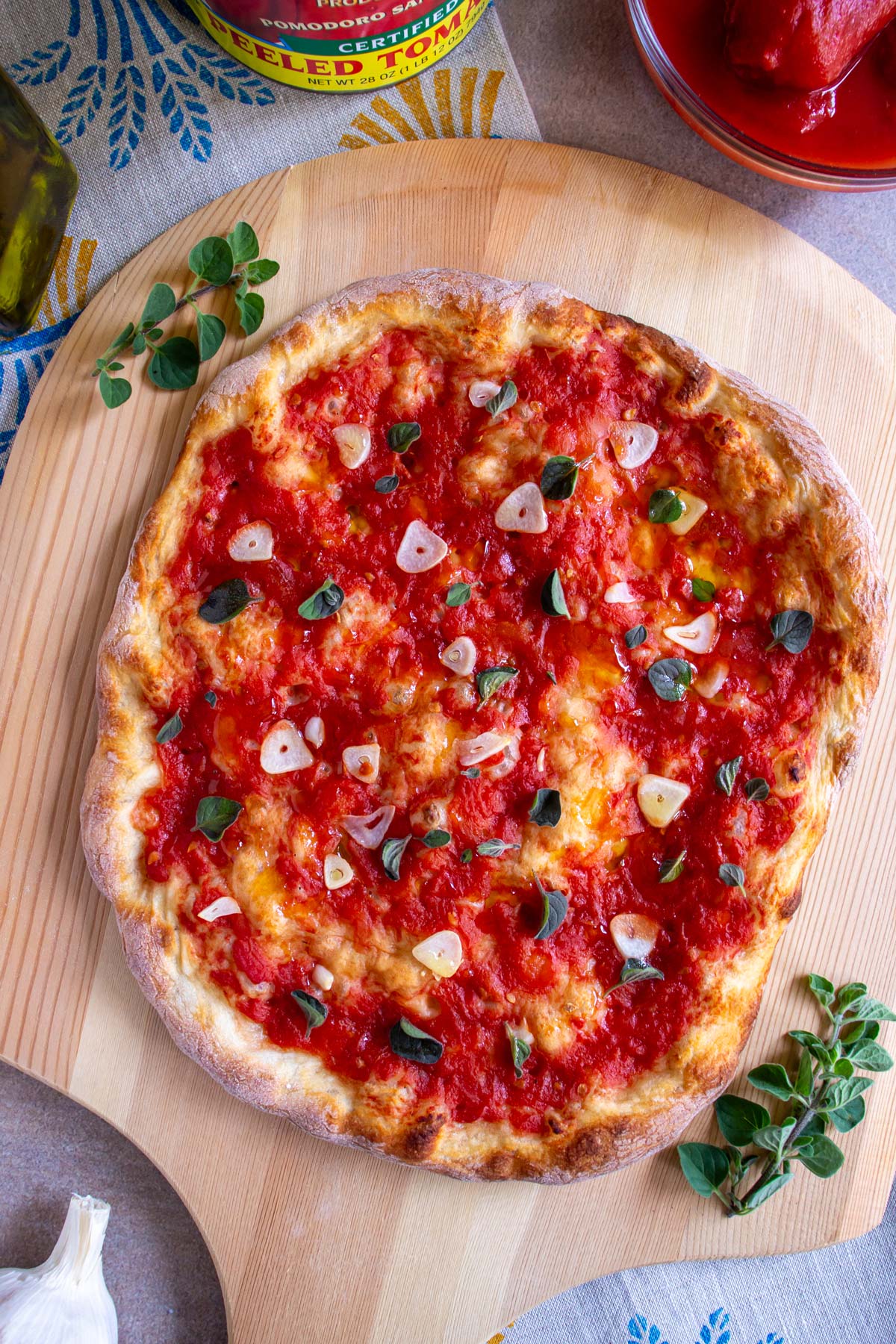
(This post was originally published in March 2012, but was updated with a new recipe, new photos and additional content in 2023).
Pizza Marinara (or Pizza alla Marinara) is one of the three official variants of traditional Neapolitan pizza. It is believed that Pizza marinara was invented in Naples in 1734 at Pizzeria Port'Alba, considered the oldest pizzeria in the world.
You may already be familiar with pizza marinara’s siblings. These are the three official variants of Neapolitan pizza.
- Pizza Marinara: Topped with tomato, garlic, oregano, and extra-virgin olive oil
- Pizza Margherita: Topped with tomato, sliced fresh mozzarella, fresh basil, and extra-virgin olive oil
- Pizza Margherita Extra: Topped with tomato, sliced fresh buffalo mozzarella, fresh basil, and extra-virgin olive oil
The name marinara supposedly refers to the fact that poor fisherman would commonly consume this style of pizza on their ships and at port because of the easily preservable ingredients. It does not, as the name suggests, contain any seafood.
The key ingredients to make pizza marinara are few, but important. Dough is topped with tomatoes, garlic, oregano, and extra-virgin olive oil. And that’s it. There’s no cheese or other embellishments on this pizza pie.
Traditional VPN (Associazione Vera Pizza Napoletana) approved pizzas are cooked at very high temperatures (about 900°F) in a wood-burning dome oven for no more than 90 seconds. They feature a thin, soft crust with a bit of bubbling and charring.
In most cases, without a special pizza oven that can reach super high temperatures, your pizza marinara won’t have quite the same texture and appearance, but it will still be delicious!
Ingredient notes
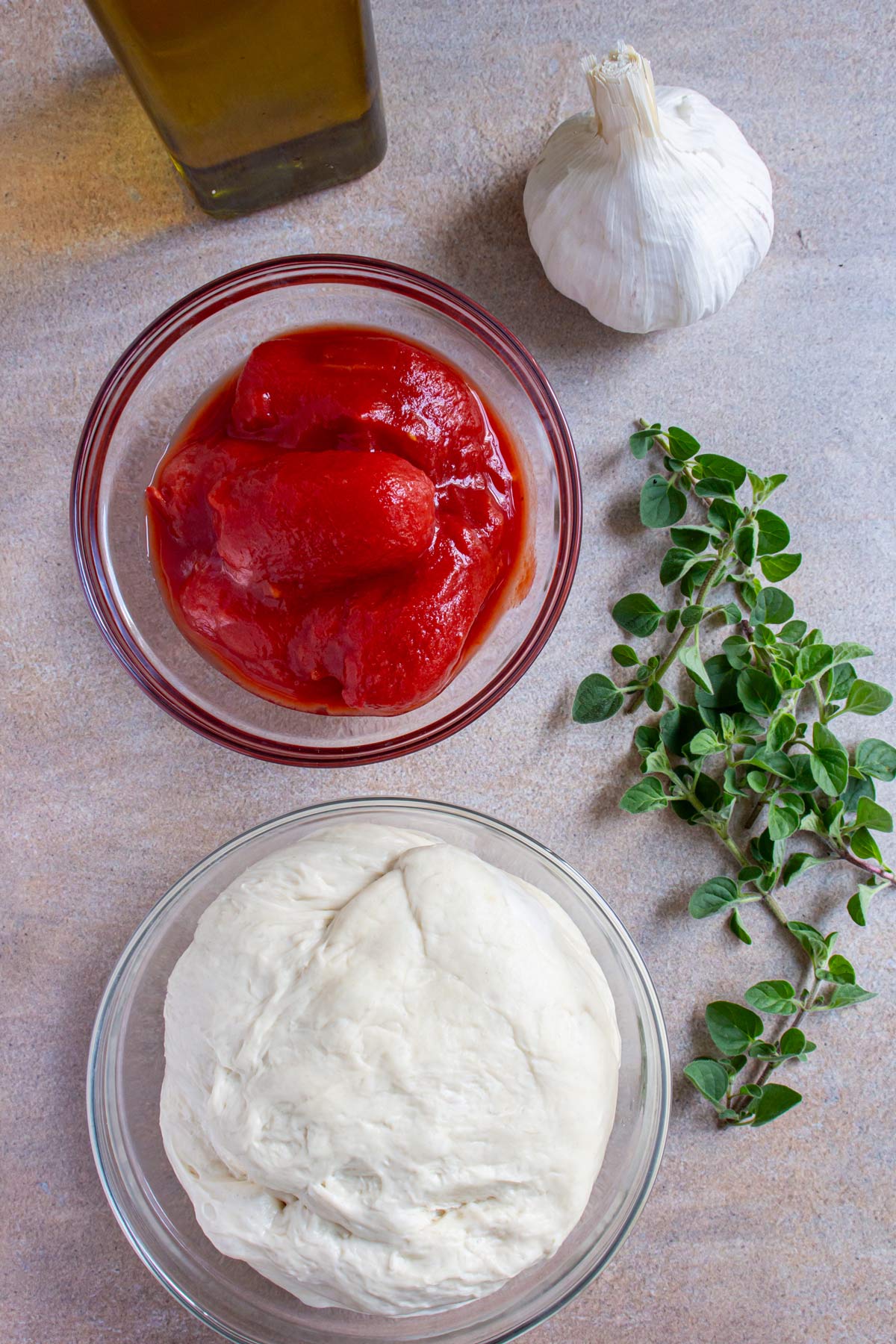
- Pizza Dough: In order to follow the authentic requirements of Neapolitan-style pizza, your dough would be made with type 0 or type 00 wheat flour, fresh (not dry) yeast, water and salt. I take the liberty of a shortcut here and suggest using any homemade or store-bought pizza dough, however you could certainly make Neapolitan-style pizza dough with the traditional ingredients if you’d like. You can purchase pizza dough at supermarkets, but even better, see if your favorite local pizza shop sells their pizza dough (many of them do!).
- Tomatoes: Neapolitan pizza is made with pureed San Marzano tomatoes from Italy. You can purchase canned San Marzano tomatoes imported from Italy, and they work perfectly here. Just beware of imitations which are sometimes labeled as San Marzano-style tomatoes and the like. Cento is the brand I typically buy for recipes requiring authentic canned San Marzano tomatoes. It's sometimes packed with a sprig of basil, so just remove the basil before crushing up your tomatoes.
- Garlic: Make sure your garlic is fresh and hasn’t sprouted. Peel and slice the cloves thinly with a sharp knife.
- Oregano: Although I typically prefer dried oregano to fresh, this is one instance where using fresh oregano leaves is worth it. That being said, you could use about half the amount of dried oregano if you needed to. Dried is more potent so you won’t need as much to top your pizza marinara.
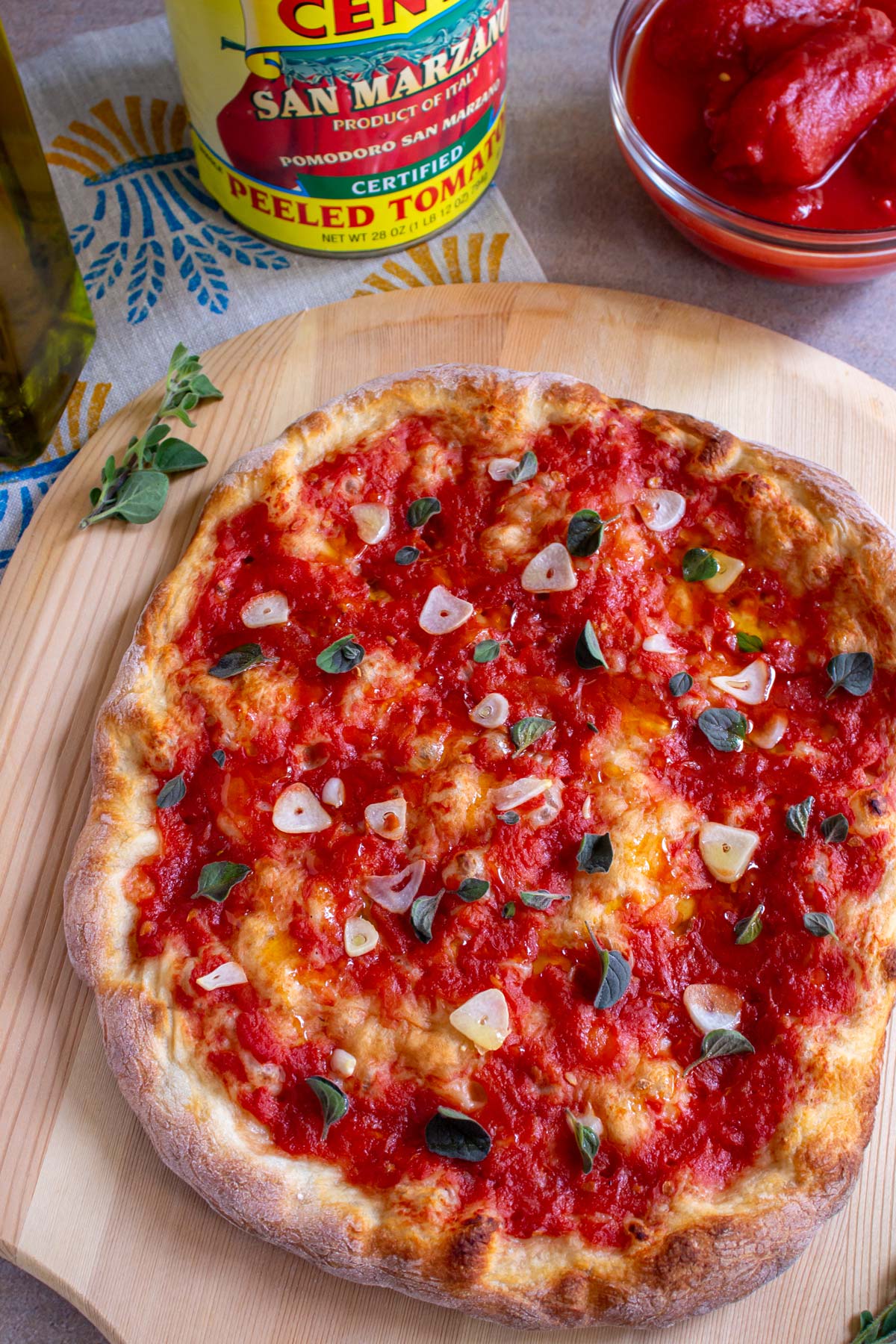
How to make it
Place a large pizza stone in the center of your oven. Preheat to the hottest temperature possible, usually 500°F (260°C) (mine heats to 550°F) for at least 30 minutes, but preferably 45 to 60 minutes. If you have a pizza oven, such as an Ooni pizza oven, heat it to 850°F (455°C).
Either crush tomatoes by hand in a bowl, process through a food mill, or pulse in a food processor until fairly smooth but still slightly textured. Add kosher or fine sea salt and stir to combine.
Working with one ball of pizza dough at a time, stretch out the dough on a lightly floured work surface until the dough reaches a diameter of 10 to 12 inches.
Lightly dust a pizza peel with all-purpose flour or semolina flour if you have some. Transfer the stretched disc of pizza dough to the peel.
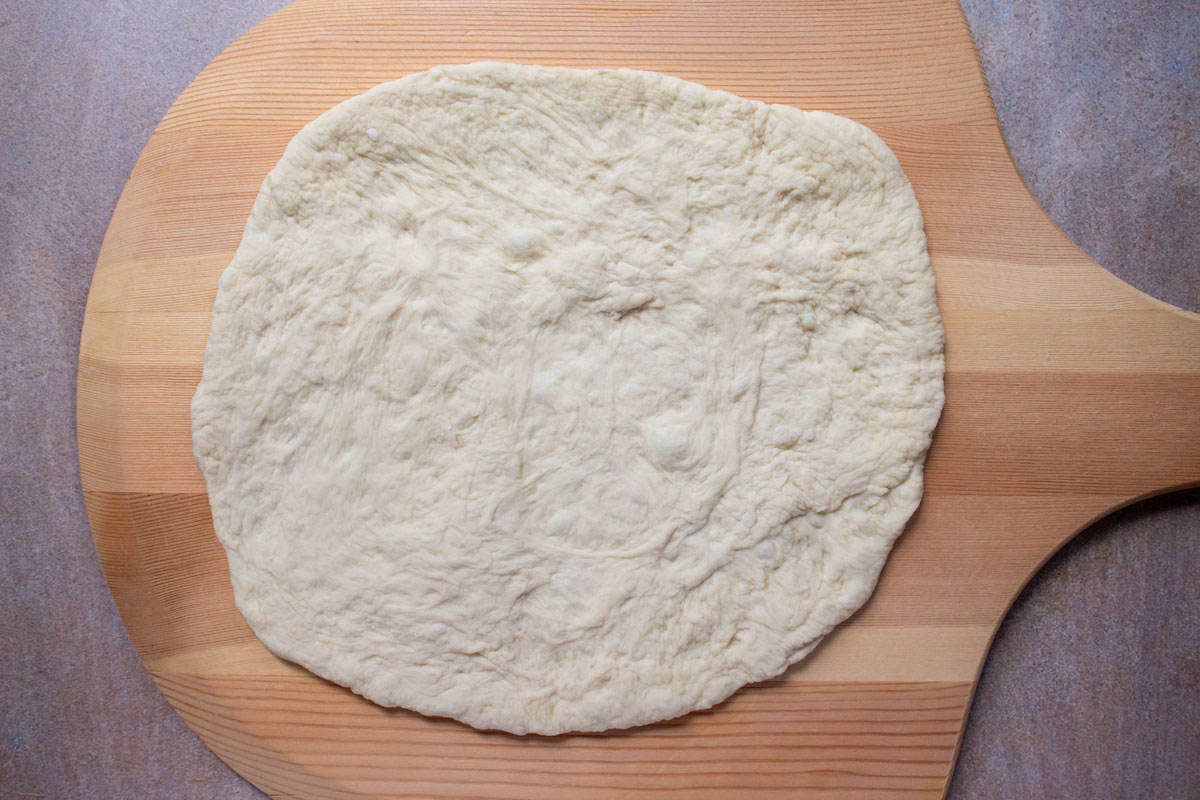
Spread half the crushed tomatoes over the dough. Leave about ½-inch rim without sauce at the edges.

Sprinkle half the sliced garlic over the top evenly.
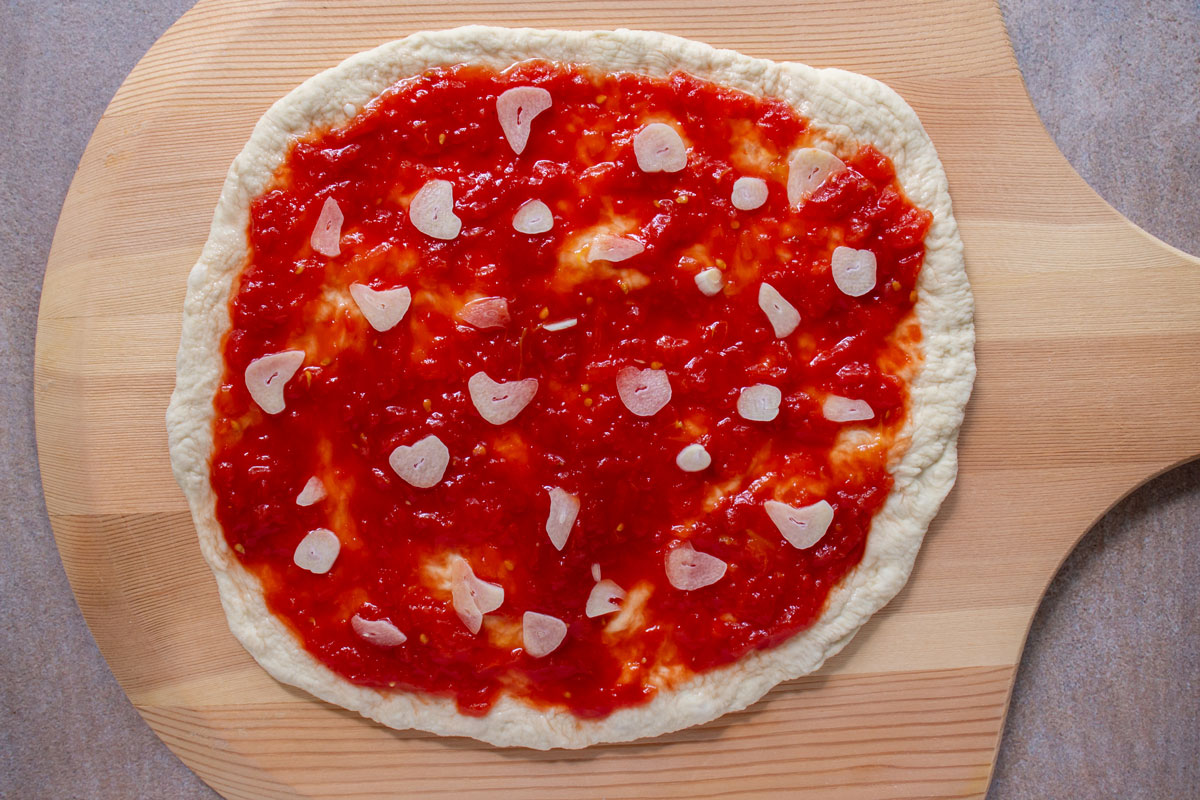
Use the pizza peel to carefully transfer the pizza onto the preheated pizza stone with quick, jerking wrist motions. Bake and crust is nicely browned, about 8 to 10 minutes in the regular oven (or 1 to 2 minutes in the specialty pizza oven).
Remove the finished pizza from the oven. Sprinkle half the fresh oregano and a pinch of salt over the top. Drizzle with half the extra-virgin olive oil. Slice pizza marinara into wedges and serve immediately.
Please scroll to the bottom of the post for the full recipe (in a printable recipe card) including ingredient amounts and detailed instructions.
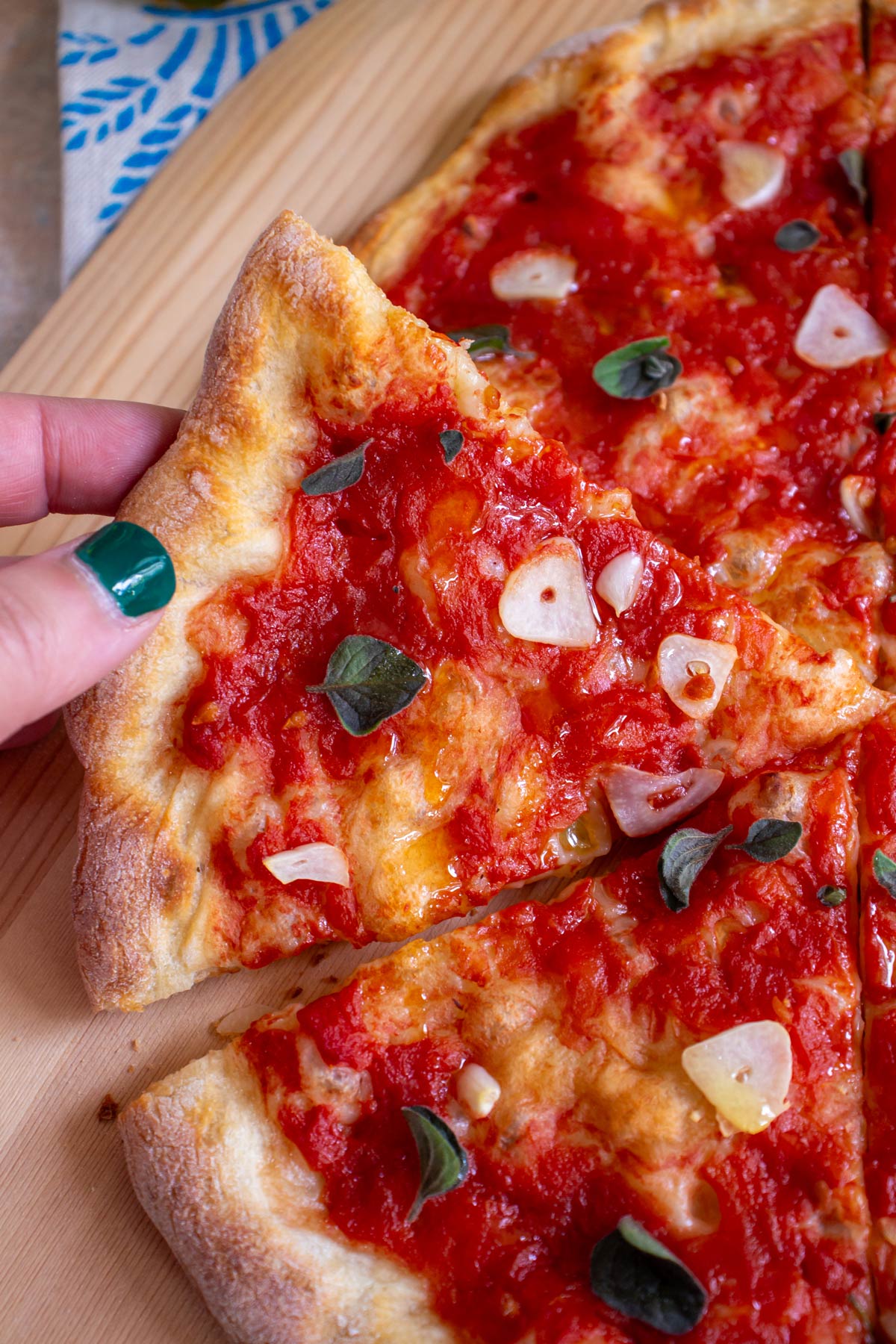
Expert tips
Different pizza doughs can result in different textured crust on your pizza. If you use an American-style pizza dough rather than the typical Neapolitan pizza dough, you will more likely get more of a crunchy and chewy crust that a soft and chewy crust.
The tomato topping may seem a bit watery at first. In the hot oven the water will quickly evaporate leaving a thick and super tomatoey result.
Equipment
A pizza stone is meant to mimic the qualities of a pizza oven. The stone itself is placed in the oven while it preheats, and the stone heats and retains that heat throughout the process of cooking your pizzas. This helps get a nice crust and allows the pizzas to cook faster.
I recommend using a large rectangular pizza stone which is large enough to cook two pizzas. I also suggest getting one that is at least ½-inch thick. It will retain the heat a lot better if it's thicker. Thinner pizza stones don't do as good a job of this.
If you have a small pizza stone: While the first pizza is baking you can stretch the remaining pizza dough. You’ll need the peel to remove the first pizza from the oven. In this case, wait to finish assembling the second pizza until after the first one comes out of the oven.
If you have a large pizza stone: With a larger pizza stone, you can bake both pizzas simultaneously.
I also recommend using a pizza peel to transfer your pizza marinara in and out of the oven. A pizza peel is the large, thin, flat paddle used to slide an assembled pizza either into a pizza oven or onto a pizza stone. It's usually made of wood or metal. I've tried using the back of a sheet pan for this purpose, and it's just not as easy. If you plan to make pizza occasionally, then definitely invest in a pizza peel.
If you are truly invested in making homemade pizza, you can also invest in a pizza oven, such as an Ooni pizza oven. This is a more expensive kitchen tool, and likely not for the average at home pizza maker.
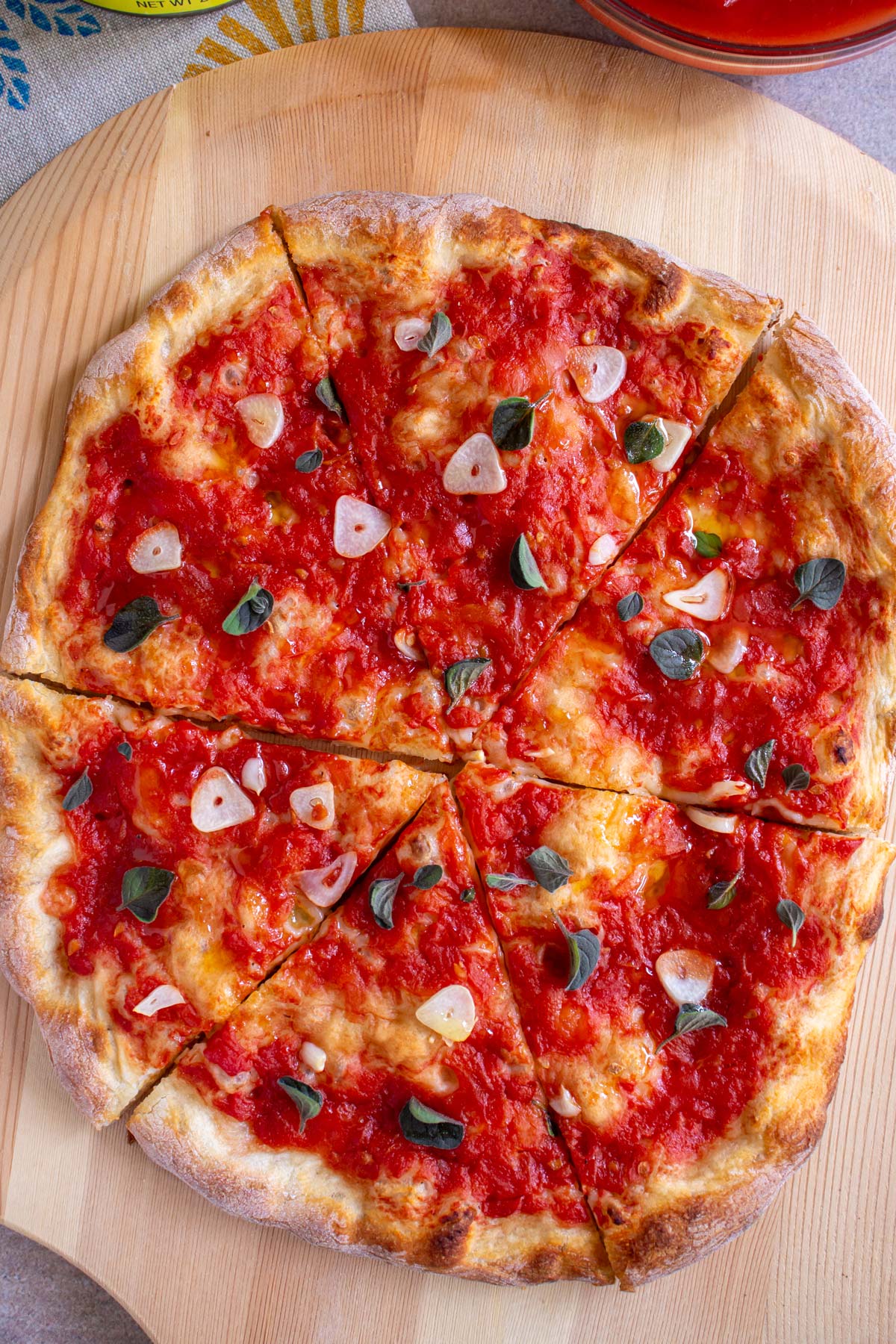
Other recipes you may like
- Corn and Tomato Pizza
- Radicchio Pizza
- Italian Stromboli with Soppressata, Rapini, and Provolone
- Meatball Calzones
- Penne all'Arrabbiata (Spicy Tomato Pasta)
- Pasta e Piselli (Pasta and Peas)
Tried this recipe? Please leave a star ⭐️⭐️⭐️⭐️⭐️ rating in the recipe card below and/or a review in the comments section further down the page. You can also follow me on social media on Facebook, Instagram, and Pinterest!
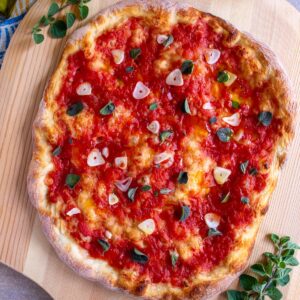
Pizza Marinara
Ingredients
- 8 ounces (225 grams) canned San Marzano tomatoes (about 5 tomatoes plus some of the puree)
- Kosher salt or fine sea salt
- 1 pound (450 grams) pizza dough (store-bought or homemade) divided into 2 balls (8 ounces or 225 grams each)
- All-purpose flour for dusting work surface
- Semolina flour (optional - for dusting pizza peel)
- 2 cloves garlic thinly sliced
- 1 tablespoon fresh oregano leaves (lightly packed)
- 1 tablespoon extra-virgin olive oil for drizzling
Instructions
- Place a large pizza stone in the center of your oven and preheat to the hottest temperature possible, usually 500°F (260°C). Ideally, preheat the pizza stone in the oven for at least 30 minutes, but preferably 45 to 60 minutes to ensure it retains as much heat as possible before baking your pizzas. If you have a pizza oven, such as an Ooni pizza oven, heat it to 850°F (455°C).
- Either crush the canned San Marzano tomatoes by hand in a bowl, process through a food mill, or pulse in a food processor until fairly smooth but still slightly textured. Add a big pinch or two of kosher or fine sea salt and stir to combine. Taste and add more if desired.
- Working with one ball of pizza dough at a time (approximately 8 ounces or 225 grams each), stretch out the dough on a lightly floured work surface. Press the dough with your fingers starting in the center and pushing out toward the edges to create a flat disc. Then place your fists under the edges of the dough and support the disc with your knuckles as you lift the edges and continue to stretch the dough. Gently pull it wider and wider until the dough reaches a diameter of 10 to 12 inches.
- Lightly dust a pizza peel with all-purpose flour or semolina flour if you have some. Transfer the stretched disc of pizza dough to the peel.
- Spread half the crushed tomatoes over the dough using the back of a large spoon in a circular motion starting at the center and moving outward. Leave about ½-inch rim without sauce at the edges. Sprinkle half the sliced garlic over the top evenly.
- Use the pizza peel to carefully transfer the pizza onto the preheated pizza stone with quick, jerking wrist motions. Bake and crust is nicely browned, about 8 to 10 minutes in the regular oven (or 1 to 2 minutes in the specialty pizza oven).
- While the first pizza is baking you can stretch the remaining pizza dough. You’ll need the peel to remove the first pizza from the oven, so wait to finish assembling the second pizza until after the first one comes out of the oven. If you have enough room in your pizza oven or on your pizza stone, you can bake both pizzas simultaneously. Otherwise, after the first pizza comes out of the oven, finish assembling and then bake the second pizza.
- Remove the finished pizza from the oven, sprinkle half the fresh oregano and a pinch of salt over the top. Drizzle with half the extra-virgin olive oil in a circular motion starting from the center and working outward. Slice into wedges and serve immediately.
Notes
- Dough: In order to follow the authentic requirements of Neapolitan-style pizza, your dough would be made with type 0 or type 00 wheat flour, fresh (not dry) yeast, water and salt. I take the liberty of a shortcut here and suggest using any homemade or store-bought pizza dough, however you could certainly make Neapolitan-style pizza dough with the traditional ingredients if you’d like.
- Tomatoes: Neapolitan pizza is made with pureed San Marzano tomatoes from Italy. You can purchase canned San Marzano tomatoes imported from Italy, and they work perfectly here. Just beware of imitations which are sometimes labeled as San Marzano-style tomatoes and the like. Cento is the brand I typically buy for recipes requiring authentic canned San Marzano tomatoes.
- Garlic: Make sure your garlic is fresh and hasn’t sprouted. Peel and slice the cloves thinly with a sharp knife.
- Oregano: Although I typically prefer dried oregano to fresh, this is one instance where using fresh oregano leaves is worth it. That being said, you could use about half the amount of dried oregano if you needed to.
- Pizza Stone: I recommend using a large rectangular pizza stone which is large enough to cook two pizzas. I also suggest getting one that is at least ½-inch thick. It will retain the heat a lot better if it's thicker. Thinner pizza stones don't do as good a job of this.
Nutrition
*All nutritional information is based on third-party calculations and should be considered estimates. Actual nutritional content will vary with brands used, measuring methods, portion sizes and more.*


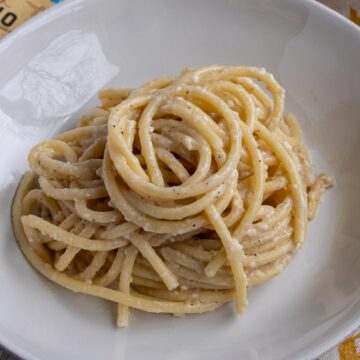
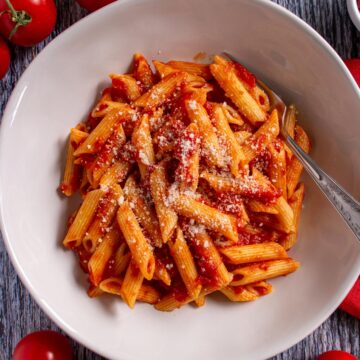

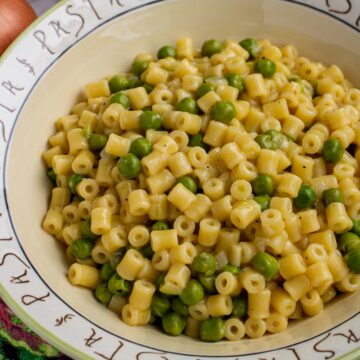
Comments
No Comments